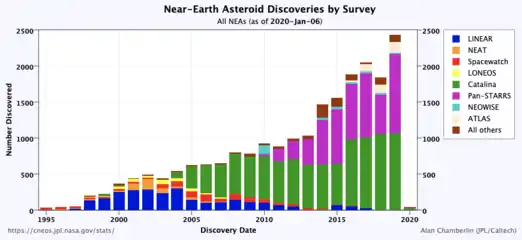Spacewatch
The Spacewatch project is an astronomical survey that specializes in the study of minor planets, including various types of asteroids and comets at Kitt Peak National Observatory near Tucson, Arizona, in the United States.
| Survey type | astronomical survey |
|---|---|
| Observatory code | 691 |
| see Category:Discoveries by the Spacewatch project |
It is led by astronomer Robert S. McMillan at the University of Arizona and was founded in 1980 by Tom Gehrels and McMillan. Spacewatch uses a 1.8 meter and a 0.9 meter dedicated telescope. In addition, it uses the Nicholas U. Mayall Telescope and the Steward Observatory's Bok Telescope for follow-up observations of near-Earth objects.[2][3]
The 36 inch (0.9 meter) telescope at Kitt Peak observatory has been in use by Spacewatch since 1984, and since 2000 the 72 inch Spacewatch telescope.[4] The 36 inch telescope continued in use and was further upgraded, in particular the telescopes use electronic detectors.[4]
Spacewatch’s 1.8-meter telescope is the largest in the world that is used exclusively for asteroids and comets.[5] It can find asteroids and comets anywhere from the space near Earth to regions beyond the orbit of Neptune and to do astrometry on the fainter of objects that are already known. The telescope is pointed and tracked on stars with a real time video camera at folded prime focus.

History
The 1.8 meter Spacewatch telescope and its building on Kitt Peak were dedicated on June 7, 1997 for the purpose of finding previously unknown asteroids and comets.[6] Since January 1 2003, Spacewatch has made ~2400 separate-night detections of Near-Earth Objects.[5]
The upgrade to the 0.9 meter was funded by NASA and the Kirsch Foundation.
Notable discoveries

|
LINEAR NEAT Spacewatch LONEOS |
CSS Pan-STARRS NEOWISE All others |
- Callirrhoe[7]
- 5145 Pholus[8]
- 9965 GNU[9][10]
- 9885 Linux[11]
- 9882 Stallman[12]
- 9793 Torvalds[13]
- 20000 Varuna[14]
- 60558 Echeclus[15]
- 1998 KY26[16]
- (35396) 1997 XF11[17]
- (48639) 1995 TL8[18]
- (136617) 1994 CC[19]
- C/1992 J1[20]
- 125P/Spacewatch[21]
- 174567 Varda[22]
- 2013 BS45[23]
- The project rediscovered 719 Albert, a long-lost asteroid.
See also
References
- "Minor Planet Discoverers (by number)". Minor Planet Center. 12 January 2017. Retrieved 3 February 2017.
- "The Spacewatch Project". University of Arizona. 2010.
- Solar Empire: Spacewatch Project
- "Spacewatch telescope detects its first asteroids". ScienceDaily. Retrieved 18 November 2018.
- McMillan, Robert S. (2006). "Spacewatch preparations for the era of deep all-sky surveys". Near Earth Objects, Our Celestial Neighbors. Proceedings of the International Astronomical Union. 2 (S236). Cambridge University Press. p. 329. doi:10.1017/S1743921307003407. ISBN 978-0521-86345-2. ISSN 1743-9213.
- "1.8-m Spacewatch telescope motion control system". SPIE. Digital Library. Retrieved 18 June 2020.
- "New outer satellite of Jupiter discovered". Minor Planet Center. Retrieved 23 July 2009.
- "5145 Pholus (1992 AD)". JPL Small-Body Database Browser. Jet Propulsion Laboratory.
- "9965 GNU". JPL Small-Body Database Browser. Jet Propulsion Laboratory.
- "SDSS/SMASS asteroid taxonomy". people.roma2.infn.it.
- "9885 Linux". JPL Small-Body Database Browser. Jet Propulsion Laboratory.
- "9882 Stallman". JPL Small-Body Database Browser. Jet Propulsion Laboratory.
- "9793 Torvalds". JPL Small-Body Database Browser. Jet Propulsion Laboratory.
- "20000 Varuna". JPL Small-Body Database Browser. Jet Propulsion Laboratory.
- "coms06". www.ast.cam.ac.uk.
- "1998 KY26". JPL Small-Body Database Browser. Jet Propulsion Laboratory.
- "MPEC 1997-Y11: 1997 XF11". Minor Planet Center.
- "MPEC 1999-L24: 1995 SM55, 1995 TL8, 1996 GQ21". Minor Planet Center.
- "(136617) 1994 CC, "Beta", and "Gamma"". johnstonsarchive.net.
- "Spacewatch Outer Solar System Discoveries". Lunar and Planetary Laboratory. University of Arizona. Archived from the original on 29 October 2008.
- "125P/Spacewatch". cometography.com.
- "174567 Varda". JPL Small-Body Database Browser. Jet Propulsion Laboratory.
- "2013 BS45". IAU Minor Planet Center.